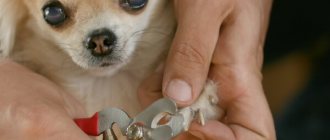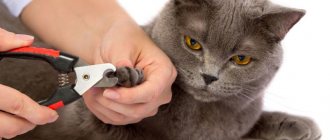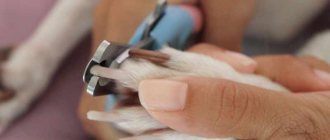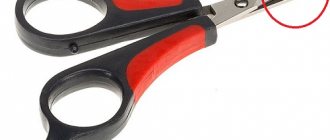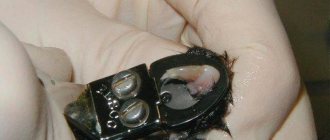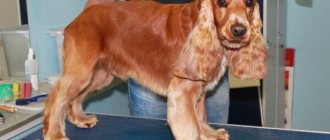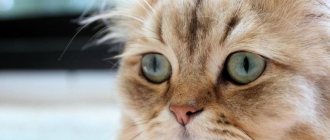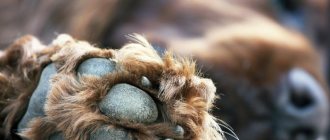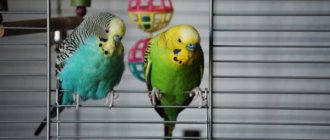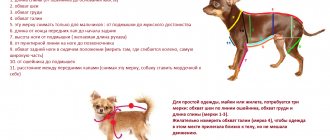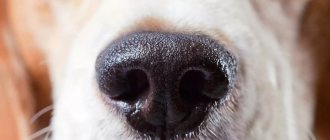Pets require special care. They have to be constantly bathed, their hair brushed, and even their nails cut. The problem of trimming dog nails is particularly relevant. Only the right nail clipper for dogs can save the pet and its owner from unnecessary hassle. It is worth finding out which nail clipper is best to buy for dogs and how much good models can cost. Moreover, it is better to do this while still preparing to buy a puppy.
Procedure for trimming nails using clippers
Types of nail clippers
Ordinary scissors are not suitable for cutting dog nails, so you won’t be able to save money on tools. Otherwise you will injure your dog. Nail clippers can be purchased at pet stores.
The main selection criterion is the size of your pet. For large dogs, choose only wire cutters. For little ones, you can choose any model, but it is best to buy a guillotine. But cat nail clippers are not suitable for small dogs.
- Scissors are the simplest model in design, but not in use. Looks like regular scissors, but has rounded edges where the claw will go;
- Nippers are a large hinged type nail clipper with a sharp sickle-shaped blade that looks like pliers. It operates on the principle of scissors. There is a spring between the handles that automatically pushes them apart when the claw is cut. This way, you don't have to put in extra effort.
- A guillotine claw cutter is a small tool consisting of a movable and a fixed part. The working surface is a circle with a hole where the claw is placed. The cutting part moves along the perpendicular to the working plane of the surface. The blade that cuts the claw comes out when the handle is pressed. The guillotine is convenient to use due to the limiter - the claw will not lie further than necessary, which means that the dog will not be injured. These models are ideal for novice dog owners without much nail trimming experience.
To process already trimmed nails, some dog owners use an electric nail clipper or grinder. With its help you can file down hard claws of any thickness. The main thing is that they are not too long, otherwise it is very inconvenient to operate such a claw clipper. This tool makes the cut line as round as possible.
The Pros and Cons of Trimming Domestic Cats' Nails
This procedure helps protect small children in the house from scratches, when an overly naughty pet can get carried away and accidentally harm the child. In addition, wallpaper, expensive furniture and other household items and clothing will not be damaged. If there are several cats in the house, this will also protect them from injuring each other during quarrels. The main argument animal advocates make against nail trimming is valid. This is the only vital “tool” of an animal, with the help of which it can climb up a tree trunk or building, defend itself from enemies, and get food for itself. Therefore, you should not trim the claws of cats that often walk outside; they are automatically at risk.
Many domestic cats that are well behaved and healthy do not need nail trimming either. They have perfectly learned to get rid of the keratinized part of the plate themselves and will never harm people or the environment in the apartment.
For young and active, exclusively domestic pets, this procedure is acceptable if performed correctly and with an excellent tool.
Nail trimming is a must:
- If you plan to take your pet to a breeding, exhibition or show. In a stressful environment, a cat may accidentally injure a partner or person.
- When the claw grows too quickly. This is typical of the Persians and Sphinxes. With a lack of vitamins D and B, the stratum corneum often peels off and breaks, and the animal may accidentally pull out a claw.
- When the pet is very old, when it is not able to grind its claws on its own. Trimming this often prevents the nail plate from growing into the paw pad.
Criterias of choice
There are several criteria for choosing a quality nail clipper. Pay attention to:
- blade - it must be sharpened so that the claw is cut and not compressed or peeled. A good nail clipper will have a blade that will leave an even and smooth cut. There should be no burrs on the cutting edges of the blade;
- handles - they must be strong and reliable. Choose models with rubber gaskets on metal handles. This way your fingers won't slip;
- Size – based not only on the size of the dog, but also on the size of your hand. The nail clipper should be comfortable to hold. A model that is too small will be inconvenient to use.
It’s good if the pet store allows you to try the chosen model in action. Take your pet with you and check how the tool cuts. If the claw is cut and not split, the steel is of high quality and well sharpened.
Reviews
About two years ago I ordered nail clippers. My friends also ordered the same big one for a Labrador. My dog is no longer afraid of the manicures I give her. The nail cutter cuts like clockwork and does not break the claw. The cut is always straight. The rubber handles are very comfortable, there is a lock and a limiter.
Masha
I now have two dogs - an adult Yorkie and a Chihuahua puppy. She chose the claw cutter herself and held it in her hand. A small dog doesn't need a big nail clipper. For Yorkies I use a guillotine. Then I process it with a file, then the claws turn out more even.
If you accidentally cut a claw until it bleeds, immediately sprinkle it with dry potassium permanganate.
Tasya
We use a nail clipper - a guillotine, as in the picture, from Trixie.
Serves for more than ten years. The dogs are medium-sized - a German Shepherd and a medium-sized mongrel. Alina
Price issue
The cost of a dog nail clipper depends on many parameters. The price is affected by the material, type and size of the tool. The most budget models will cost 200-300 rubles, more expensive ones – 600-700 rubles, and prices for large pruners reach 1000-1500 rubles. The grinder can be found on sale at a price of about 1000 rubles.
When choosing a nail clipper, do not skimp. Trust well-known manufacturers with reliable products. Such a nail clipper will serve your pet for many years, and during use it will not injure him, because the blade will be of high quality. With cheap nail clippers, the cutting part will quickly become dull, and you will have to change the tool. Otherwise, the dog's claws will not be cut, but will flake off. High-quality steel will not rust quickly.
Tool cost
Dog nail clippers, which resemble regular scissors, can be purchased for as little as 200 rubles.* Devices that act like a guillotine are also considered inexpensive. For example, Hello Cat and Cascade cost less than 300 rubles.
Guillotine
Nail clippers-secateurs are already more expensive, which affects their service life and reliability. Negative reviews are associated only with the cost of the product, but there is no doubt about its quality. So, depending on the manufacturer, on average, accessories have a price from 400 to 800 rubles.
An electric grinder can be purchased for 2 thousand. You will have to spend only 400 rubles on a product from the Russian brand Markethot.
How to use a nail clipper
Having decided on the choice of a nail clipper, all that remains is to learn how to use it. Follow the instructions:
- sit against the light, take the dog’s paw in your hand;
- gently press on the pad so that the claw comes out;
- examine the claw in the light - you will see where the blood vessels pass - you must not touch them;
- You need to trim the claw at a right angle in several movements;
When trimming your dog's nails, take your time. You should pause every couple of claws to calm your pet if you need to. If you are in a hurry, there is a risk of cutting off a lot at once and getting on your nerves. The dog will feel pain, and in the future the procedure will be associated with pain. If you still hit a nerve, take a break, comfort your pet, play with him. Return to cutting after about an hour and be especially careful. When you're done with the haircut, take a special file and trim the edges of the claws.
To perform the grooming more professionally, it makes sense to take your dog to the veterinarian for the first time to observe his actions. Having adopted the experience, you will be able to carefully handle dog claws at home.
Source
Features of use
Before the procedure, the owner must calm down, otherwise the pet will feel fear and behave nervously. If the animal is still afraid, then carry out the procedure several times as accurately as possible, however, do not cut the claws. Such preparation is necessary so that the dog understands the procedure and feels more confident. Over time, use the nail clipper on a pencil or other object to demonstrate a special sound to your pet. Trim 1 claw after 5-7 preparatory procedures.
Accompany the preparation process with rewards and treats. The goal is for the dog to understand the procedure and its safety in as much detail as possible.
At this time, it is especially important not to offend the animal or cause pain. Trimming nails is not difficult, but you need to be patient and careful.
Rules for using guillotine and pruning tools.
- Sterilize nail clippers with alcohol or vodka. You also need to disinfect your hands or gloves. The dog's paws should also be washed and dried.
- If possible, you can trim the nails immediately after bathing. At this time they are as soft and pliable as possible.
- Take a close look at your pet's claws. If they are light, the pulp (tissue with blood vessels) will be easy to see. It is important not to touch it when circumcising. The cut should be located 1.5-2 mm from the edge of the pulp.
- If the dog has black claws, then you need to cut them 0.5 mm at a time. The procedure should be completed as soon as a pink dot or a place that looks like a wet spot appears in the middle of the claw.
- Start cutting the claws off the front paws. The dog must stand on the floor or a special non-slip table.
- With your left hand, press the pad of your finger to extend the claw.
- With a quick movement, make a cut at a 45° angle towards the inside of the foot by 1 mm.
- Continue cutting 0.5mm increments until you are the desired distance from the pulp.
You cannot cut the claw straight to the pulp in one movement. The risk of injury is too great. If you touch living tissue, it will hurt the animal. If the dog twitches at this moment, then there is a risk of completely tearing out the claw.
You don’t have to complete the procedure, but postpone it for a while if the dog becomes nervous.
The principle of using a trimmer is slightly different from cutting tools. There is no need to trim the claws, they are simply filed. Grinders have several attachments in a set, which are made from grinding stone.
Power tools take longer because they get hot and need to be turned off. It’s even better for the dog, because it’s not so scary.
How to choose a nail clipper
Before purchasing a nail clipper, you need to carefully examine your pet's claws. Thin and translucent claws can be trimmed with special scissors or forceps. Thick nails are best shortened using a guillotine nail clipper. An electric grinder will also work.
At the time of selection, it is recommended to hold the instrument in your hand. It should fit comfortably in the palm of your hand and not create discomfort. It is also worth paying attention to the blades: they must be sharp. As a rule, such models are more expensive. Despite this, it is better not to skimp on the health of your pets.
The handles of the product must be rubberized. This will avoid loss of control during the procedure. If it is not possible to purchase such a nail clipper, you can buy a tool with plastic handles.
First aid for injuries
Even experienced owners may experience situations where the pruning procedure becomes stressful. This could be due to a huge number of factors, ranging from a dull instrument to a sharp sound outside the window that frightened the pet.
It is important to remain calm and clearly understand the algorithm of actions in the event of an injury.
Pulp trauma
If the pruning is done too short, there is a high risk of damaging a large number of blood vessels. In this case, heavy bleeding and sharp pain occur;
This is interesting: The best shampoo for volume
It is the owner's job to stop the bleeding and calm the dog. Try to distract your pet. You should not shout at him, because the animal is in severe pain;
Using brilliant green, an alcohol solution of iodine, or other alcohol-containing antiseptics will only increase the pain. Therefore, many breeders prefer to treat open wounds with antiseptic powder.
You might find our article useful: Home veterinary first aid kit for dogs
This is important: If an injury occurs, and the first aid kit does not have the necessary medications, then experts advise stopping the bleeding with the help of flour.
Claw detonation
This situation arises in case of uncertain actions of the owner. Slow squeezing of the nail clipper by the owner in combination with a sharp jerk of the paw at the moment of manipulation can lead to disastrous results.
As a result, the claw becomes caught in the instrument and the skin and soft tissues rupture. The owner should:
- Remember that this is very painful for your four-legged pet. Therefore, he will try to break free and run away;
- The injured limb should be bandaged with gauze or a tourniquet in the metatarsal area; Raise the limb upward to stop bleeding;
- Apply cold to the injured paw. This could be an ice pack, food or fruit from the freezer;
- Open lesions should be treated with lidocaine. In its absence, this drug can be replaced with novocaine;
- If the wound is too large or the gap needs to be stitched, you should immediately seek help from a veterinarian.
This is important: before you remove frozen food from the freezer, place it in a bag and then wrap it in a towel or cloth. This will help avoid hypothermia. Also, you should not hold the cold on the injured limb for long to avoid frostbite.
The owner should remember that if an injury occurs, the dog must be left alone and not continue the nail trimming procedure for a period of 5-10 days.
Best Animal Nail Scissors
Nail scissors are a tool that looks like regular scissors. On each blade there are special rounded cutouts into which pets' claws are placed.
Hello PET 1903
The scissors are designed for trimming the nails of rabbits, cats and birds. The nail clipper is made of hardened high quality steel. This material ensures a long service life. The length of the product is 8.5 cm and the weight is only 35 g.
The blade of the scissors has a double sharpening, which ensures precise cutting of the claws. Moreover, this model is equipped with rubberized handles, thanks to which the nail clipper does not slip out of your hands during use.
If damage does occur
Initially, it should be noted that the blood vessels of each pet are a strictly individual system, which can be affected by both an experienced doctor and a beginner in this matter. But don’t immediately panic and rush to the veterinary clinic. The wound must be thoroughly treated with an antiseptic solution and the bleeding should be stopped as much as possible using talc or manganese crystals.
If the bleeding is very severe, it is necessary to call a veterinarian at home or take the animal to a clinic where it will be treated.
The best nail clippers
The tongs are nail clippers for dogs and cats with thick rubberized handles. Tools of this type are additionally equipped with a special mechanism that blocks the blades. There is also a limiter necessary for adjusting the cut of the claws.
Hello PET 20112S
This model is made of hardened stainless steel. High-quality material ensures long service life. The pliers are made in the form of pruning shears and are intended for cutting the claws of small domestic animals.
The length of the product is 8.5 cm, and the weight is about 100 g. Hello PET 20112S is equipped with comfortable rubberized handles that do not allow the product to slip out of your hands during the procedure. Moreover, the tongs are equipped with a limiter that prevents damage to your pet's nails. There is also a lock on the handle for secure storage.
- fit comfortably in the hand;
- the handle does not slip during use;
- low price;
- compactness.
- Not suitable for all pets.
Ksenia M. The size is excellent for a Jack Russell Terrier, I think it will be suitable for small breeds. Very comfortable, cuts great.
Marina P. Excellent quality, moderately sharp in order to properly trim the Sphynx cat’s claws.
DeLIGHT 40112S
DeLIGHT 40112S is a small nail clipper and pruner made of high quality plastic and metal. For precise cutting, double sharpening is provided on the blades. For safe use, the manufacturer has equipped the product with a stopper and a lock.
Preparation
To ensure your haircut is successful the first time, prepare:
- Decide on a location. Large breed dogs will be more comfortable on the floor, while small four-legged friends may want to place a blanket on a table or other high surface. The dog needs to be introduced to the place at the stage of training him to trim his nails;
- Prepare antiseptic agents, cotton pads and a nail clipper with a nail file. Watch the video in advance and read the instructions on how to properly use the selected tools;
- Calm down, dogs feel nervous. If you or your dog have recently been stressed, it is better to postpone the procedure;
- Find a partner —it’s not only more fun together, but also more reliable. You may need help distracting your dog or restraining him during the procedure;
- Get the treat. Goodies should be on hand;
- Play it safe. If the dog is not familiar with the procedure, then put a short leash and muzzle on it. For small breeds, a thick diaper is useful, in which you can wrap your pet if he gets scared. By securing your pet, you will prevent possible injuries from sudden movements.
Trimming nails Before trimming your dog’s nails, you need to carry out the following hygiene procedures:
- Trim the hair between your toes if it gets in the way;
- Wash and dry your paws;
- Inspect the paw pads for cuts, wounds, cracks, or fungus. If inflammation or fungus is detected, haircuts are not performed. You need to contact a veterinarian for treatment;
- Treat tools with boiling water or antiseptic, and wash your hands with soap.
Advice. To check the operation of the nail clipper, practice on branches. This way you will understand the principle of operation of the tool and determine the cutting angle.
The best guillotine nail clippers
A guillotine is a tool that differs in design and operating principle. The pet's nail is placed in a round recess, after which the knife of the tool cuts off the protruding part. The only drawback of the product is that it does not allow you to see how long the claw needs to be cut.
Hello PET 1781
The tool is made of hardened high quality steel. Stainless steel ensures long service life. This model is equipped with a spring mechanism and rubberized handles. Thanks to this, the conterez does not slip in your hands during use. Hello PET 1781 is suitable for treating the claws of rabbits, cats, dogs and birds.
- low price;
- sharp blades;
- comfortable shape;
- high build quality.
Mikhail Ts. Excellent working nail clipper! The cat didn’t even move, although he behaved very restlessly with other similar instruments. Lightweight, ergonomic, sharp sharpening. Excellent quality .
Anastasia N. An irreplaceable thing! A very convenient nail clipper. Easy to trim nails and fast!
What is the tool for?
From time to time, pets have to trim their nails. The regularity of the procedure depends on a number of conditions:
- For small breeds, the procedure is carried out 1-2 times every two weeks. Miniature dogs rarely walk on their own and spend a lot of time in the arms of their owners. Their claws grow quickly, but do not wear down naturally.
- Large dogs are groomed no more than once a month. At the same time, they carefully observe the animal. As soon as he started gnawing on his paws, you could hear him walking, clicking on the floor, there is no point in postponing the manipulation.
A dog's claws do not always grind down well naturally.
Note! In long-haired breeds, overgrown claws may be hidden. That is why it is recommended to get rid of the hair between the fingers by carefully cutting it.
What happens if you don't shorten your claws?
Untimely treatment of claws can lead to unpleasant consequences:
- It becomes difficult for the animal to walk, and in rare cases, the gait changes.
- The claws grow into the skin, which provokes inflammation. Pus may accumulate in the damaged area. If the situation gets worse, surgery will be required.
- The direction of the fingers changes. As a result, when walking, the load is distributed incorrectly. This not only affects your gait, but can cause joint problems.
The claws wear down when walking during walks. But this is not enough to make the dog comfortable, so you have to help the pet shorten its claws. When cutting, you need to act carefully so as not to damage the soft tissues. Nerve endings are located along the entire length of the claw; they grow with it.
You only need to cut off a small piece of it at a time so that it doesn’t hurt the dog. A nail clipper will help you cope with the task. You cannot use ordinary scissors and clippers from a manicure set, they will only harm the animal.
Differences in the type of fastening of working blades
- With adjusting screw.
- With regular riveting.
- According to the nature of the cut.
- Direct.
- Curved.
- Thinning.
- Round ends
Special for animals
With adjusting screw
A very convenient option. On such scissors, by tightening or loosening the screw, you can adjust the quality of the cut and the “stroke” of the blades. This is an almost necessary function for grooming, because... The coat of different dogs can vary greatly in hardness, density, and length.
The most important thing is not to overtighten the screw. If this happens, the working cloths will not cut off the fur, but will wring it, causing severe discomfort to the dog.
Scissors with an adjusting screw vary in blade length - from 4.5 to 8.5 inches (11.5-22 cm). The shorter the blade, the easier it is to work with such a tool in hard-to-reach areas of the body, but it is less comfortable to cut hair in large areas. For cutting large volumes of fur (back, sides, etc.), it is wiser to use scissors with a blade of at least 8 inches (20 cm) in length.
With an adjusting screw, scissors can be used with any type of cut - straight, curved, thinning.
The cost of such a tool varies from 1000 rubles. and more.
With regular riveting
An alternative to scissors with an adjusting screw is riveted scissors, a more budget option, they do not have the function of adjusting the working blades, otherwise everything is the same. They can be straight or rounded.
Straight with micro-notch
Direct
Straight - have very small notches (micro notches) on one of the working blades, which do not allow the hairs to slip off when making a cut and thereby provide a clear and even line.
Can be long or short (see description of scissors with adjusting screw). The cost of such a tool can vary from 500 rubles. and higher, depending on the reputation of the manufacturer, the materials from which the scissors are made and the ability to regulate the tension of the blades with a special adjusting screw.
Curved
Curved
Curved - a variant of straight scissors. The difference is that the ends of the working blades have a curved shape. This tool is very convenient for trimming the interdigital space, ears, tail, giving round shapes to the muzzle or any other parts of the body.
Thinning
Thinning – scissors for thinning wool. With such a tool you can both defuse (lighten) the fur and artificially create volume - this is a matter of the groomer’s skill and cutting technology. Thinning scissors also allow you to make smooth transitions from long to short hair, connecting different cutting areas and giving it a complete image and silhouette.
Thinning scissors look almost like regular straight ones, but have significant differences from them. Firstly, thinnings always have blunt ends to avoid injury, and secondly, one or both of them have specific teeth that evenly separate the hairs into strands and some of them are cut off and some are left. Due to this, the effect of thinning the entire mass of hairs is achieved, but the length of the strand remains the same.
Thinning
Thinning scissors can be double-sided or single-sided, i.e. the teeth are located either on both blades or on one.
Working with single-sided scissors is more difficult. This requires special skill and a lot of experience, which is why groomers often use double-sided thinning in their work. But, if the dog has hard, coarse and thick hair, then one-sided thinning can be safely used.
Double-sided ones are also suitable, but only with a large tooth pitch. The thicker and coarser the coat, the larger the pitch of the teeth on the thinning should be. With a small step, thinning scissors simply cannot cut such wool.
The length of the thinning is usually approximately the same - 14-15 cm, and the cost can vary as well as for straight scissors, depending on the manufacturer and the presence of an adjustment screw.
With rounded ends
Round ends
There is also this type of scissors. Both straight and curved canvases have rounded ends. These scissors are convenient for working with matted wool. You can not only trim unnecessary strands of your dog’s hair, but also at the same time pull out heavily matted areas with the tips. At the same time, it will be more convenient to comb heavily matted wool with a tangle cutter.
Where else can you get your hair cut?
Trimming dog nails is an essential part of caring for your pet. If you don’t know how or are afraid to trim nails, contact a veterinarian, groomer or experienced dog breeder.
Specialist help
Pros and cons of carrying out the procedure in a veterinary clinic:
- Waste of money;
- Necessity of travel;
- Stress in an animal due to a change of environment, unfamiliar people, unpleasant manipulations;
- Fast procedure;
- Useful tips from an expert.
Why you shouldn’t do onychotomy
Many owners, tired of problems with damaged furniture and torn walls, decide to take radical measures - onychectomy. There is definitely no need to do this!
Surgical intervention involving complete declawing is possible only for medical reasons, and not to satisfy the wishes and whims of the cat owner. “Soft paws” can solve the problem of property damage, but deprive the pet of natural protection and the necessary skills for living in a normal environment. They certainly make him flawed and cause irreparable harm to the psyche.
Even with positive results of the operation, after recovery, the pet will never be the same as before. Knowing this, it’s worth thinking: should you decide or not?
Fluffy four-legged pets decorate human life, but require care and attention. They have their own reflexes, natural instincts, which owners do not always like. When finally deciding to get a cat, it is important to remember: this is not a toy, but a living creature!
